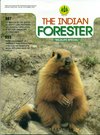Estimation of the Status of Asiatic Lion (Panthera leo persica) Population in Gir Lion Landscape, Gujarat, India
DOI:
https://doi.org/10.36808/if/2018/v144i10/139564Keywords:
Asiatic Lion, Population Estimation, Gir Landscape, EndangeredAbstract
Carnivore conservation necessitates their population estimation. Owing to the elusiveness of carnivores that precludes direct observations, their population estimation is primarily a difficult task. The only population of Asiatic lion is found in the Gir forests and its adjoining landscape of Gujarat, India where under the strict and stringent protection of the erstwhile Nawab of Junagarh and subsequently the State-run Forest Department, their numbers have bounced back from the brink of extinction. At present 523 individuals live encompassing a total area of over 7000 km2 in the Gir and Greater Gir landscape in Gujarat, Western India. Asiatic lions are among the few large carnivores which have been managed and counted since a very long time. In this paper, elucidation of the history of population estimation of lions in the Gir forests, and put forth a new- management oriented yet scientifically robust technique of enumerating the status of Asiatic lions, an endangered carnivore nurtured and scientifically managed since 5 decades.References
Carbone C. and John L.G. (2002). A common rule for the scaling of carnivore density. Science, 295:2273-2276.
Choudhury S.R. (1970). Let us count our tigers. Cheetal, 14: 4151.
Dalvi M.K. (1969). Gir lion census, Indian Forester, 95:741-752.
Divyabhanusinh C. (2005). The story of Asia's lions. Marg Publication, Mumbai, India, 259 pp.
Fuller T.K. (1989). Population dynamics of wolves in north-central Minnesota. Wildlife Monographs, 3-41.
Funston P., Frank L., Stephens T., Davidson Z., Loveridge A., Macdonald D.M., Durant S., Packer C., Mosser A. and S.M. (2010). Substrate and species constraints in the use of track incidences to estimate African large carnivore abundance. J. Zoology, 281:56-65
Garshelis D.L. (1992). Mark-recapture density estimation for animals with large home ranges. Wildlife 2001: populations. Springer Netherlands. 1098-1111.
Gore A.P., Paranjape S.A., Rajgopalan G. Kharshikar A.V., Joshi N.V., Watve M. and Gogate M. (1993). Tiger census: role of quantification. Current Science, 64: 711-714.
Grogan R.G. and Lindzey F.G. (1999). Estimating population size of a low-density black bear population using capture-resight. Ursus, 117-122.
Hayward M.W., O'Brien J. and Kerley G.I. (2007). Carrying capacity of large African predators: predictions and tests. Biological Conservation, 139:219-229.
Houser A.M., Somers M.J. and Boast L.K. (2009). Spoor density as a measure of true density of a known population of freeranging wild cheetah in Botswana. J. Zoology, 278: 108–115.
Jhala Y.V., Qureshi Q., Bhuva V and Sharma L.N. (1999). Population estimation of Asiatic lions. J. Bombay Natural History Society, 96: 1-15.
Joslin P. (1973). The Asiatic lion: a study of ecology and behaviour. University of Edinburg.
Karanth K.U. and Nichols J.D. (1998). Estimation of tiger densities in India using photographic captures and recaptures. Ecology, 79: 2852-2862.
Karanth K.U., Chundawat R.S., Nichols J.D. and Kumar N. (2004). Estimation of tiger ensities in the tropical dry forests of Panna, Central India, using photographic capture-recapture sampling. Animal Conservation, 7: 285-290.
Knowlton F.F. and Tzilkowski W.M. (1979). Trends on bobcat visitations to scent-station survey lines in western United States, 8-12: In: Proceedings of Bobcat Research Conference: Current Research on Biology and Management of Lynx rufus.
Mech L.D. (1996). A new era for carnivore conservation. Wildlife Society Bulletin, 24(3): 397-401.
Minta S.C., Kareiva P.M. and Curlee A.P. (1999). Carnivore research and conservation: learning from history and theory. Carnivores in ecosystems: the Yellowstone experience. Yale University Press, New Haven, Connecticut, USA: 323-404.
Palomares F., Ferreras P., Fedrinai J.M. and Delibes M. (1996). Spatial relationships between Iberian lynx and other carnivores in an area of south-western Spain. J. Applied Ecology, 33: 5–13.
Schaller G.B. (1967). The Deer and the Tiger. A Study of Wildlife in India. University of Chicago Press.
Singh H.S. (1997). Population dynamics, group structure and natural dispersal of the Asiatic lion Panthera leopersica. J. Bombay Natural History Society, 94: 65-70.
Singh H.S. and Luke Gibson (2011). "A conservation success story in the otherwise dire megafauna extinction crisis: the Asiatic lion (Panthera leopersica) of Gir forest. Biological Conservation, 144: 1753-1757.
Singh H.S. (2007). The Gir lion Pantheraleopersica- a natural history, conservation status and future prospect. Pugmark Qumulus Consortium, Ahmedabad, India, 320 pp.
Smallwood K.S. and Fitzhugh E.L. (1993). A rigorous technique for identifying individual mountain lions Felis concolor by their tracks. Biological Conservation, 65: 51–59.
Smuts G.L., Whyte I.J. and Dearlove T.W. (1977). A mass capture technique for lions. African J. Ecology, 15: 81-87.
Soisalo M.K. and Cavalcanti S.M.C. (2006). Estimating the density of a jaguar population in the Brazilian Pantanal using camera-traps and capture–recapture sampling in combination with GPS radio-telemetry. Biological Conservation, 129: 487–496.
Stander P.E. (1998). Spoor counts as indices of large carnivore populations: the relationship between spoor frequency, sampling effort and true density. J. Applied Ecology, 35: 378-385.
Tende T., Ottosson U., Hansson B., Ã…kesson M. and Bensch S. (2010). Population size of lions in Yankari Game Reserve as revealed by faecal DNA sampling. African J. Ecology, 48: 949952.
Treves, Adrian and Karanth K.U. (2003). Human carnivore conflict and perspectives on carnivore management worldwide. Conservation Biology, 176: 1491-1499.
Wilcox B.A. and Dennis D.M. (1985). Conservation strategy: the effects of fragmentation on extinction. The American Naturalist, 1256: 879-887.
Woodroffe R. and Joshua R.G. (1998). "Edge effects and the extinction of populations inside protected areas. Science, 280(5372): 2126-2128.
Wynter-Blyth M.A. and Dharmakumarsinhji K.S. (1950). The Gir forest and its lions, pt. II. J. Bombay Nat. Hist. Soc, 49: 456-470.
Wynter-Blyth M.A. (1956). The lion census of 1955. J. Bombay Natural History Society, 53(4): 527-536.
Downloads
Downloads
Published
How to Cite
Issue
Section
License
Unless otherwise stated, copyright or similar rights in all materials presented on the site, including graphical images, are owned by Indian Forester.





